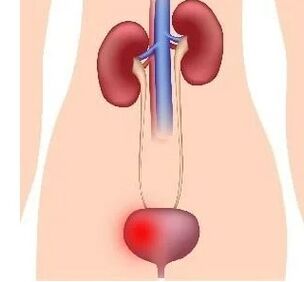Cystitis- This is a pathology, characterized by the development of an inflammatory process that affects the bladder wall as a result of the effects of bacterial microorganisms.

Statistical cystitis- One of the most common urological pathologies. Women are predisposed much more to the occurrence of this inflammation, due to their morphophysiological characteristics.
Bacterial agents who enter the bladder cavity are possible in three ways:
- The Ascending Way- Through the urethra (urethra). The main role in this version of the penetration of microorganisms belongs to the anatomical and morphological characteristics of the female urinary tract: a short, wide urethra, closely dismissed with the anus and vagina.
- Descendant path- From the kidneys. This option develops as the course of kidney inflammation, for example chronic pyelonephritis.
- Hematogenic path- The most rare option is established when cystitis occurs immediately after infectious diseases or when another source of purulent infection in the female body is detected. There is also a probability of bacterial microflora in the bladder due to the presence of anatomical anastomoses (connections) between the lymphatic vessels of the genital organs and the bladder, subject to inflammatory changes in the above.
The most common causative agent of the inflammatory process of the bladder is E. coli (in 4 of 5 cases, which is associated with the aforementioned anatomical and morphological characteristics and the presence of this microflora in the intestine).
Less commonly, cystitis is associated with staphylococcal, streptococcal and enterococcal microorganisms. -Gram -black sticks cause inflammation of the bladder due to instrumental and surgical interventions.
Recently, the incidence of cystitis associated with fungal microorganisms, the simplest and viruses increased.
Only the introduction of infectious microorganisms is not sufficient for the development of a complete inflammatory response in the bladder, because the body contains mechanisms of resistance to the action of pathogenic flora.
Cystitis Development Factors
Thus, in addition to the etiological factor, factors such as ::
- HEMODYNAMIC FUNCTION DISORDER(blood circulation) of the pelvic organs and, in particular, the bladder;
- Bladder Excretory Function Disorder(Urine stagnation);
- inhibition of various immune bonds of the body(lack of vitamins, exposure to low temperatures, stress, increased fatigue etc. );
- Passionate effects of biochemical agentsand change products released in the urine to the bladder wall structure;
- exposure to radiological rays;
- non -compliance with hygieneExternal genitalia and random sexual relations;
- gastrointestinal tract pathology, in the presence of which the microflora accumulates and increases its activity, which later enters the urinary tract;
- Regular changes in hormonal metabolismwhich leads to the lack of tone of the urethra and creates the best conditions for the infection.

The first symptomatic manifestations of cystitis in women
The acute cystitis clinic in a woman is characterized by a sudden start and a complex of pronounced symptomsWith:
- The appearance of frequent urination (Pollakiuria)which is characterized by a frequency at least once every 60 minutes and small volumes of the released urine; With the development of frequent imperative desires, patients are unable to control and maintain urine;
- Dysuria (violation of urination)accompanied by pain in the hypogastric region (in the lower abdomen). With the development of the inflammatory process in the bladder wall, these symptoms progress: the more it is developed, the more often the desire to urinate and the more intense pain;
- Itching in the urinary tractemerging during the act of urination. It is developed due to exposure to the mucous membrane of urinary tract products from microorganism metabolism that caused bladder inflammation;
- The appearance of drops of bloodat the end of the urination law;
- The appearance of cloudy urinedue to the entry of a large number of blood cells (leukocytes and red blood cells), bacterial microflora, cells of the epithelium of the inner wall surface of the bladder;
- These patients are not characterized by a change in the general condition.Patient temperature indicators are characterized by normal or slightly increased numbers (low grenade). Scientists associate this with the fact that the bladder mucosa membrane is hardly sucked in the metabolic products of microorganisms, which, having entered the blood, usually leads to body intoxication and the development of characteristic symptoms of inflammation.
The connection of sudden symptoms and anterior hypothermia of the body of the woman who appeared. Sometimes acute inflammation phenomena can be observed for 2-3 days and disappear independently without the use of therapy.

However, most of the time this process takes more than 6 days, sometimes up to 15 days. The presence of a later disease, subject to the appointment of therapy, requires the appointment of additional examination methods to identify the concomitant pathologies of the body.
Characterization of pain with cystitis in women
In patients with acute cystitis, a different degree of pain syndrome severity is observed:
- In the mild course of the inflammatory process, patients feel severity or insignificant pain in the lower abdomen.Sensitive pain at the end of the urination law accompany the moderate polakiuria. With the additional development of the inflammatory process, pain intensity increases. Subsequently, this syndrome follows the beginning or the whole act of urination. The pain is not related to the act and acquires almost constant in nature, is accompanied by very painful palpation about the projection of the bladder.
- In a situation where heavy cystitis developed, patients need to urinate at least 2-3 times per hour, which is accompanied by significant pain syndrome and the appearance of urethine blood discharge at the end of the law. Pain significantly worsens the patient's quality of life because they do not disappear every day.
The presence of blood cells and blood in the urine with cystitis (hematuria syndrome)
When an inflammatory process develops on the bladder walls, it affects tissue areas near the confluence of urethrers and the urethra output. The fabric is loose and bleeding.
This is manifested by the appearance of micro and macrohematuria (or blood) in the urine, which is often observed at the end of the urination law (terminal hematuria).
One of the most severe forms of acute cystitis is hemorrhagic. This type of inflammation occurs with a significant penetration of red blood cells (red blood cells) of the bloodstream of the nutritious arteries in the bladder cavity.
This option is possible in case of increased permeability of blood vessel walls (condition for anemia, vitamin deficiency, disorders in blood system operation) or damage to the above walls with bacterial cells (usually streptococal flora). The red blood cells that fell into the urine of the bubble cavity spot on the blood stone.
When hematuria occurs, the doctor is obliged to carefully conduct differential diagnoses between acute cystitis and complicated acute form - hemorrhagic cystitis. For this, additional examination methods are prescribed, the type of injury is clarified and the most correct therapy scheme is selected.
Characteristics of the course of acute and chronic cystitis in women
Clear cystitis
Summing up the above information, the sharp start can be distinguished from the disease and the presence of a particular symptom complex for acute cystitis:
- frequent urination in small portions,
- Pain syndrome of various nature,
- itching that is associated with the act of urination,
- The appearance of blood falls at the end of the law,
- The unchanged general condition of women.
With a true and timely diagnosis, the pathological condition is healed within 6 to 10 days. In the absence of improvements after the 15th day of the disease course, it is worth thinking about the chronization of inflammatory changes.

In addition to the hemorrhagic, there are two more forms of complicated course of acute cystitis:
- Gangrenous.The gangrenous form is rarely found and occurs due to impaired blood supply or bladder innervation. Clinically, this cystitis manifests itself by difficulty in urination, accompanied by pain, high body temperature, pain in the sacral region. The process is extremely dangerous for the development of formidable complications, such as peritonitis and requires rapid measures for treatment.
- Phlegmonous.The phlegmosa form is manifested by significant body intoxication, high body temperature and is accompanied by the release of a small amount of urine (oliguria). The urine, with such a complicated chain, acquires a putrefactive smell, muddy character, fibrin formations flakes, blend of blood.
The duration of the pathology course in the case of the development of complicated forms increases significantly.
There is another form of cystitis - interstitial.It is characterized by the inflammation of all membranes of the urine bubble. The clinic is dominated by very rapid urination, reaching up to 180 times a day, active complaints of intense pain in the hypogastric region by filling the bladder and its regression after the urination law. Bubble capacity is significantly reduced as a result of the above symptoms.
Chronic cystitis
Chronic cystitis, in contrast to acute, rarely occurs as a primary pathology and, in most cases, is a secondary complication of the course of existing bladder, kidneys, urethral pathologies.
Given this fact, it is necessary to carefully examine the body to the presence of pathological changes above, and exclude or confirm the specific origin of microorganisms - tuberculosis stick, trichomonas invasion.
Clinically, chronic cystitis manifests itself by a continuous course with moderate differences in complaints and clinical analysis of urine, or in the form of a recurring pathology with periods of exacerbation (similar to the clinic of acute cystitis) and complete regression (with the absence of any manifestations of the pathological process).
Thus, the objective manifestations of chronic cystitis correspond to such in the acute process. They correlate with the common protection properties of the body, the etiology of a bacterial agent that caused an infectious process and the degree of severity of inflammation. Pain, frequent urination, itching, blood presence and cloudy cloudy are less pronounced with constant course and correspond to the acute process with the recurring course of chronic cystitis.
Due to the injury of the inflammatory reaction of the mucosa, the edema of all layers of the urined wall and the increased intrapear pressure created all the conditions for the formation of vesicular-memorial reflux, that is, the bladder launch liquid back to the ureter (connects the kidneys and bubble).

The Urologist is involved in verifying the diagnosis and the purpose of cystitis therapy.
To correctly diagnose inflammatory pathology, it is necessary to clearly fix the complaints of patients and their history (which preceded the development of pathology).
Clinical manifestations are quite specific and may immediately indicate the presence of this disease; However, it is necessary to carefully make the differential diagnosis between all types of cystitis, as well as other bladder pathologies and abdominal organs.
From anamnesis, data on the tensions and influences of low temperatures, medicines taken, as well as other lesions located in the pelvic organs and the genitourinary system, will be useful.
After clarifying the complaints and an anamnesis, clinical urine analysis (general) may help check the diagnosis - increased white and red blood cell levels will be detected in it (leukocytes and red blood cells, respectively).
To identify the type of bacterial microorganism that caused the inflammatory process, urine is sowing special nutrients, which can be used in the future to choose the most effective antibacterial drug.
Prior to the urine fence for bacteriological examination, it is necessary to qualitatively treat the area of external genitalia with an anti -support solution. The conduction of cystoscopy in the presence of acute inflammatory reaction is against -indicated.
To diagnose chronic cystitis, along with the collection of complaints and data on the anamnesis, cystoscopy helps during remission. This will establish all the necessary characteristics of an inflammatory disease. With this manipulation, it is possible to take biopsy material to the mucous membrane of the urine bubble. In addition, to identify chronic cystitis, a contrast -x radius study is recommended.
























